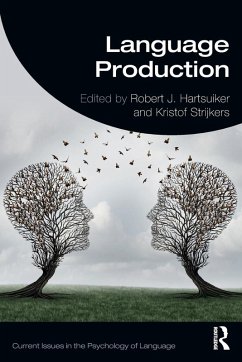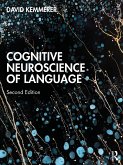Language Production
Herausgeber: Hartsuiker, Robert J.; Strijkers, Kristof
Language Production
Herausgeber: Hartsuiker, Robert J.; Strijkers, Kristof
- Broschiertes Buch
- Merkliste
- Auf die Merkliste
- Bewerten Bewerten
- Teilen
- Produkt teilen
- Produkterinnerung
- Produkterinnerung
Bringing together the latest research from world-leading academics, this edited volume is an authoritative resource on the psycholinguistic study of language production, exploring longstanding concepts as well as contemporary and emerging theories.
Andere Kunden interessierten sich auch für
![Cognitive Neuroscience of Language Cognitive Neuroscience of Language]() David Kemmerer (USA Purdue University)Cognitive Neuroscience of Language153,99 €
David Kemmerer (USA Purdue University)Cognitive Neuroscience of Language153,99 €![Advances in the Neurolinguistic Study of Multilingual and Monolingual Adults Advances in the Neurolinguistic Study of Multilingual and Monolingual Adults]() Advances in the Neurolinguistic Study of Multilingual and Monolingual Adults49,99 €
Advances in the Neurolinguistic Study of Multilingual and Monolingual Adults49,99 €![Experimental Methods in Embodied Cognition Experimental Methods in Embodied Cognition]() Experimental Methods in Embodied Cognition39,99 €
Experimental Methods in Embodied Cognition39,99 €![Linguistic Morphology in the Mind and Brain Linguistic Morphology in the Mind and Brain]() Linguistic Morphology in the Mind and Brain42,99 €
Linguistic Morphology in the Mind and Brain42,99 €![The New Psychology of Language The New Psychology of Language]() Ton DijkstraThe New Psychology of Language58,99 €
Ton DijkstraThe New Psychology of Language58,99 €![Psychopharmacology Psychopharmacology]() R. H. Ettinger (USA East Oregon University)Psychopharmacology114,99 €
R. H. Ettinger (USA East Oregon University)Psychopharmacology114,99 €![The Chatterbugs Manual The Chatterbugs Manual]() Andrea RichardsThe Chatterbugs Manual69,99 €
Andrea RichardsThe Chatterbugs Manual69,99 €-
-
-
Bringing together the latest research from world-leading academics, this edited volume is an authoritative resource on the psycholinguistic study of language production, exploring longstanding concepts as well as contemporary and emerging theories.
Produktdetails
- Produktdetails
- Current Issues in the Psychology of Language
- Verlag: Taylor & Francis Ltd
- Seitenzahl: 340
- Erscheinungstermin: 16. März 2023
- Englisch
- Abmessung: 234mm x 156mm x 18mm
- Gewicht: 530g
- ISBN-13: 9780367703417
- ISBN-10: 0367703416
- Artikelnr.: 66724904
- Herstellerkennzeichnung
- Libri GmbH
- Europaallee 1
- 36244 Bad Hersfeld
- gpsr@libri.de
- Current Issues in the Psychology of Language
- Verlag: Taylor & Francis Ltd
- Seitenzahl: 340
- Erscheinungstermin: 16. März 2023
- Englisch
- Abmessung: 234mm x 156mm x 18mm
- Gewicht: 530g
- ISBN-13: 9780367703417
- ISBN-10: 0367703416
- Artikelnr.: 66724904
- Herstellerkennzeichnung
- Libri GmbH
- Europaallee 1
- 36244 Bad Hersfeld
- gpsr@libri.de
Robert J. Hartsuiker is Professor of Psychology at Ghent University, Belgium. His research interests include language processing, language production, bilingualism, and self-monitoring of speech. Kristof Strijkers is a Researcher at the Centre National de la Recherche (CNRS) and Aix-Marseille University, France. His research examines the spatiotemporal dynamics of language production and comprehension, and the neural representations of words in the brain.
Introduction 1. Grammatical Encoding 2. Lexical Access in Speech
Production: Psycho- and Neurolinguistic Perspectives on the Spatiotemporal
Dynamics 3. Phonological Processing: Planning the Sound Structure of Words
from a Psycholinguistic Perspective 4. The Neural Organisation of Language
Production: Evidence from Neuroimaging and Neuromodulation 5. The
Electrophysiology of Language Production 6. Self-Monitoring: The
Neurocognitive Basis of Error Monitoring in Language Production 7.
Bilingual Language Production: A tale About Interference Resolution in
Different Linguistic Contexts 8. Written Production: The APOMI Model Of
Word Writing: Anticipatory Processing of Orthographic and Motor Information
9. Sign Production: Signing vs. Speaking: How Does the Biology of
Linguistic Expression Affect Production? 10. Co-Speech Gesture 11.
Understanding Language Use in Social Contexts: The Role of Past and Present
Discourse Contexts 12. Joint Language Production and the Representation of
other Speakers' Utterances
Production: Psycho- and Neurolinguistic Perspectives on the Spatiotemporal
Dynamics 3. Phonological Processing: Planning the Sound Structure of Words
from a Psycholinguistic Perspective 4. The Neural Organisation of Language
Production: Evidence from Neuroimaging and Neuromodulation 5. The
Electrophysiology of Language Production 6. Self-Monitoring: The
Neurocognitive Basis of Error Monitoring in Language Production 7.
Bilingual Language Production: A tale About Interference Resolution in
Different Linguistic Contexts 8. Written Production: The APOMI Model Of
Word Writing: Anticipatory Processing of Orthographic and Motor Information
9. Sign Production: Signing vs. Speaking: How Does the Biology of
Linguistic Expression Affect Production? 10. Co-Speech Gesture 11.
Understanding Language Use in Social Contexts: The Role of Past and Present
Discourse Contexts 12. Joint Language Production and the Representation of
other Speakers' Utterances
Introduction 1. Grammatical Encoding 2. Lexical Access in Speech
Production: Psycho- and Neurolinguistic Perspectives on the Spatiotemporal
Dynamics 3. Phonological Processing: Planning the Sound Structure of Words
from a Psycholinguistic Perspective 4. The Neural Organisation of Language
Production: Evidence from Neuroimaging and Neuromodulation 5. The
Electrophysiology of Language Production 6. Self-Monitoring: The
Neurocognitive Basis of Error Monitoring in Language Production 7.
Bilingual Language Production: A tale About Interference Resolution in
Different Linguistic Contexts 8. Written Production: The APOMI Model Of
Word Writing: Anticipatory Processing of Orthographic and Motor Information
9. Sign Production: Signing vs. Speaking: How Does the Biology of
Linguistic Expression Affect Production? 10. Co-Speech Gesture 11.
Understanding Language Use in Social Contexts: The Role of Past and Present
Discourse Contexts 12. Joint Language Production and the Representation of
other Speakers' Utterances
Production: Psycho- and Neurolinguistic Perspectives on the Spatiotemporal
Dynamics 3. Phonological Processing: Planning the Sound Structure of Words
from a Psycholinguistic Perspective 4. The Neural Organisation of Language
Production: Evidence from Neuroimaging and Neuromodulation 5. The
Electrophysiology of Language Production 6. Self-Monitoring: The
Neurocognitive Basis of Error Monitoring in Language Production 7.
Bilingual Language Production: A tale About Interference Resolution in
Different Linguistic Contexts 8. Written Production: The APOMI Model Of
Word Writing: Anticipatory Processing of Orthographic and Motor Information
9. Sign Production: Signing vs. Speaking: How Does the Biology of
Linguistic Expression Affect Production? 10. Co-Speech Gesture 11.
Understanding Language Use in Social Contexts: The Role of Past and Present
Discourse Contexts 12. Joint Language Production and the Representation of
other Speakers' Utterances









